
Jules Gabriel Verne was a French novelist, poet, and playwright. His collaboration with the publisher Pierre-Jules Hetzel led to the creation of the Voyages extraordinaires, a series of bestselling adventure novels including Journey to the Center of the Earth (1864), Twenty Thousand Leagues Under the Seas (1870), and Around the World in Eighty Days (1872). His novels, always well-researched according to the scientific knowledge then available, are generally set in the second half of the 19th century, taking into account the technological advances of the time.

Twenty Thousand Leagues Under the Seas is a science fiction adventure novel by the French writer Jules Verne. It is often considered a classic within both its genres and world literature. The novel was originally serialised from March 1869 to June 1870 in Pierre-Jules Hetzel's French fortnightly periodical, the Magasin d'éducation et de récréation. A deluxe octavo edition, published by Hetzel in November 1871, included 111 illustrations by Alphonse de Neuville and Édouard Riou.
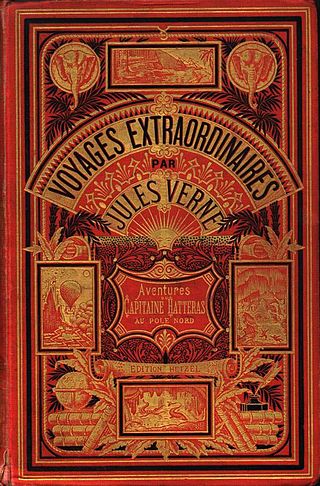
The Voyages extraordinaires is a collection or sequence of novels and short stories by the French writer Jules Verne.

The Obscure Cities, first published in English as, variously, Stories of the Fantastic and Cities of the Fantastic, is a bande dessinée series created by Belgian artist François Schuiten and French writer Benoît Peeters. First serialized in magazine format in 1982, the series has been published in album format by Brussels-based publisher Casterman since 1983. New installments of the series were published throughout the 1980s, 1990s, 2000s, and 2020s, with full-color, partial color, or black-and-white artwork, as well as photo illustration. The artwork of the series is distinguished by Schuiten's realistic rendering of diverse contemporary, historical, and imaginary architectural styles.

The Green Ray is a novel by the French writer Jules Verne published in 1882 and named after the optical phenomenon of the same name. It is referenced in a 1986 film of the same name by Eric Rohmer.

Dr. Ox's Experiment is a humorous science fiction novella by the French writer Jules Verne, published in 1872. It describes an experiment by one Dr. Ox, and is inspired by the real or alleged effects of oxygen on living things.

Facing the Flag or For the Flag is an 1896 patriotic novel by Jules Verne. The book is part of the Voyages extraordinaires series.

César Cascabel is a novel written by Jules Verne in 1890. It is part of Voyages Extraordinaires series. It was published in English in two-volume form, with subtitles "The Show on Ice" and "The Travelling Circus".

"A Drama in Mexico" is a historical short story by Jules Verne, first published in July 1851 under the title "L'Amérique du Nord, études historiques: Les Premiers Navires de la marine mexicaine."

Mutineers of the Bounty, translated in English by English writer W. H. G. Kingston, is a short story by Jules Verne. The story is based on British documents about the Mutiny on the Bounty and was published in 1879 together with the novel The Begum's Fortune, as a part of the series Les Voyages Extraordinaires.
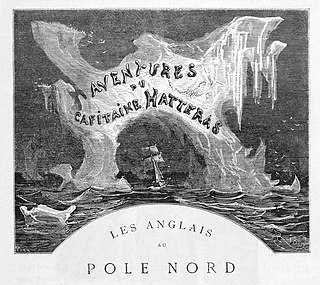
The Adventures of Captain Hatteras is an 1864 adventure novel by Jules Verne in two parts: The English at the North Pole and The Desert of Ice.

Jules-Descartes Férat was a French artist and illustrator, famous for his portrayals of factories and their workers.
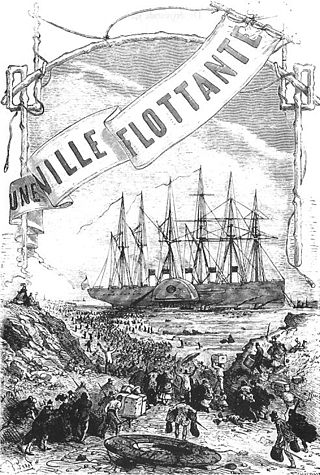
A Floating City, or sometimes translated The Floating City, is an adventure novel by French writer Jules Verne first published in 1871 in France. At the time of its publication, the novel enjoyed a similar level of popularity as Around the World in Eighty Days. The first UK and US editions of the novel appeared in 1874. Jules Férat provided the original illustrations for the novel.

The Adventures of Three Russians and Three Englishmen in South Africa is a novel by Jules Verne published in 1872.

The Village in the Treetops is a 1901 novel by French author Jules Verne. The book, one of Verne's Voyages extraordinaires, is his take on Darwinism and human development.
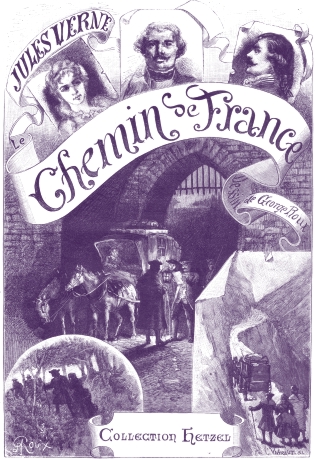
The Flight to France is an adventure novel written by Jules Verne. Set in the year 1792 just before the French Revolutionary Wars, the novel follows fictional French Army Captain Natalis Delpierre. Several English language editions were published with the subtitle, The Flight to France; or, The Memoirs of a Dragoon. A Tale of the Day of Dumouriez.
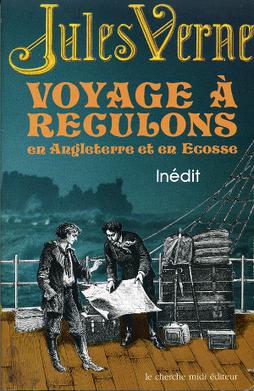
Backwards to Britain is a semi-autobiographical novel by the French writer Jules Verne, written in the fall and winter of 1859–1860 and not published until 1989.

Journey Through the Impossible is an 1882 fantasy play written by Jules Verne, with the collaboration of Adolphe d'Ennery. A stage spectacular in the féerie tradition, the play follows the adventures of a young man who, with the help of a magic potion and a varied assortment of friends and advisers, makes impossible voyages to the center of the Earth, the bottom of the sea, and a distant planet. The play is deeply influenced by Verne's own Voyages Extraordinaires series and includes characters and themes from some of his most famous novels, including Twenty Thousand Leagues Under the Seas, Journey to the Center of the Earth, and From the Earth to the Moon.

Jules Verne (1828–1905) was a French novelist, poet, and playwright. Most famous for his novel sequence, the Voyages Extraordinaires, Verne also wrote assorted short stories, plays, miscellaneous novels, essays, and poetry. His works are notable for their profound influence on science fiction and on surrealism, their innovative use of modernist literary techniques such as self-reflexivity, and their complex combination of positivist and romantic ideologies.
Henry Frith was an Irish engineer who translated the works of Jules Verne and others, as well as writing his own works. His prolific output amounted to nearly 200 works between translations, novels, and instructional titles.



















